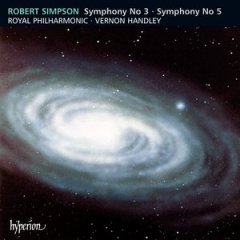Robert Simpson - Symphonies Nos. 3 & 5 (1994)
Robert Simpson - Symphonies Nos. 3 & 5 (1994)

1 Symphony No. 3 - 1962: Allegro ma non tropo
2 Symphony No. 3 - 1962: Adagio play
3 Symphony No. 3 - 1962: Adagio
4 Symphony No. 3 - 1962: Adagio
5 Symphony No. 3 - 1962: Adagio
6 Symphony No. 3 - 1962: Adagio
7 Symphony No. 3 - 1962: Adagio
8 Symphony No. 3 - 1962: Adagio
9 Symphony No. 3 - 1962: Adagio
10 Symphony No. 5 - 1972: Allegro
11 Symphony No. 5 - 1972: Allegro
12 Symphony No. 5 - 1972: Allegro
13 Symphony No. 5 - 1972: Allegro play
14 Symphony No. 5 - 1972: Canone 1: Comodo e tranquillo
15 Symphony No. 5 - 1972: Scherzino: Molto vivace
16 Symphony No. 5 - 1972: Canone 2: Adagio
17 Symphony No. 5 - 1972: Finale: Molto allegro e con fuoco
Royal Philharmonic Orchestra
Vernon Handley – conductor
Recording:
14 February 1994, St Augustine's Church, Kilburn, London (Symphony 5)
24 May 1994, St Augustine's Church, Kilburn, London (Symphony No 3)
Surely Robert Simpson ranks among the greatest symphonists of the twentieth century. The Third, Fifth, and Ninth symphonies are probably his greatest achievements, though I would be hard-pressed to say which of these three is the greatest. A good case can be made for the Fifth, however, which is certainly one of the most original works ever composed. If you have never sampled any of Simpson's symphonic works, this is probably the best place to start. Be prepared, however: Simpson's works are highly dissonant in nature, and they demand a lot from the listener. That dissonance is produced primarily as a result of his style of composition, which is governed by the presence of two opposing tonal centers, which often collide against each other. Simpson's music is not atonal, but bi-tonal.
Not for Simpson the angst that characterizes the symphonies of Shostakovich and Pettersson. Instead, there is a much more formal detachment, devoid of any traces of emotion. All the same, his music is fraught with a Brucknerian majesty. As one reviewer has said, it is as though one is encountering some sort of strange interstellar phenomenon, utterly beyond the realm of human experience. This is of course their weakness and their strength.
The Third is probably best-known for its extended last section, which starts as an Adagio and gradually accelerates over the space of some 15 minutes to eventually explode in "Beethovenian momentum". The Fifth is best-known for that incredible single-note pulse which plays in the background throughout most of the work, for the most part inaudible, except at the beginning and at the very end of the work where it quietly endures sphinx-like in absolute triumph. It brings to mind that same enigma that confronts the listener in Ives' "Unanswered Question": Whence the cosmos?, and all those unutterable questions that flood the mind when looking up into the night sky.
This is a remarkable recording, with exceptionally well-written album notes. Bravo to Hyperion for its most excellent Simpson series! It's my sincere hope that Simpson's time will eventually come. His music deserves to be heard. These two symphonies are undeniably among the most original symphonic works of our time.
download: uploaded yandex 4shared mediafire solidfiles mega zalivalka filecloudio anonfiles oboom
Last Updated (Sunday, 11 May 2014 20:45)








